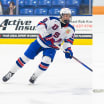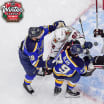Lehner tended to retreat toward the goal line, especially as plays moved down the wings and deeper into the offensive zone. Though that was enough to keep him in the middle of the net, he didn't stay square to the puck. Instead he often would get caught flat, or parallel to the goal line, which made him look smaller and opened holes in his 6-foot-4, 240-pound frame.
"If you are off-angle or not square, you are in awkward positions to make saves and you open up holes and give the shooter net to look at," Lehner said. "If you are square, there's no net."
Lehner is better now at rotating his body as he works back toward his posts with smaller, shorter movements, keeping himself square to the shooter.
"I am 10 times more square than I have ever been," Lehner said. "A guy with my frame, even pucks I don't see hit me because I am keeping my line and I am square all the time. A lot of goalies have a problem being flat instead of staying square to the shooter and they have done a good job of teaching me to recognize that, where before I wasn't able to do it because I am too far out and I am moving too much. Now even if I am square and in the middle of the net, or even one foot off my goal line, I am square and I am a big guy and I have reflexes."


















